Bicycling is a fun activity for the whole family, but safety is paramount any time you ride. With the recent media coverage of brain and head injuries associated with all types of actives, you probably already recognize the importance of wearing a helmet and staying alert, so today we’re going to focus on the laws in Texas regarding cycling.
First, the basics:
Tex. Transp. Code § 551.101 establishes the fact that bikes are entitled to all rights and obligated to all duties of the road that apply to a motor vehicle. Specific rights or duties may be altered by the Texas Transportation Code, or when a right or duty applicable to a driver by its nature cannot apply to a cyclist.
In short, this tell us that when riding a bicycle, we are operating a vehicle in the eyes of the law. But to better understand the specifics of cycling in Texas, you must take a closer look at the Transportation Code. Check it out:
- A person operating a bicycle, if moving slower than traffic, shall ride as near as practicable to the right curb or edge of the roadway. By definition, roadway does not include the shoulder of the road.
- A person operating a bicycle shall ride only on or astride a permanent and regular seat attached to the bicycle.
- A person may not use a bicycle to carry more persons than the bicycle is designed or equipped to carry.
- A person operating a bicycle, coaster, sled or toy vehicle, or using roller skates may not attach either the person or the bicycle, coaster, sled or toy vehicle, or roller skates to a streetcar or vehicle on the roadway.
- A person operating a bicycle may not carry any object that prevents the operator from keeping at least one hand on the handlebars.
- Bicyclists must use hand signals to signal their intent to stop, turn left, or turn right. The bicyclist must use the following signals:
- Stop – Extend the left hand and arm downward
- eft Turn – Extend the left hand and arm horizontally
- Right Turn – Extend the left hand and arm upward, or extend the right arm horizontally
- Every bike must be equipped with a brake capable of making a braked wheel skid on dry, level, clean pavement.
- A person may not operate a bicycle at nighttime unless the bicycle is equipped with the following:
- Headlamp – a lamp on the front of the bicycle that emits a white light visible from a distance of at least 500 feet in front of the bicycle.
- Red Reflector/Red Lamp – A bicycle must be equipped with either a red reflector which is visible from a distance of 300 feet from the rear of the bicycle, or a red lamp visible from a distance of 500 feet from the rear of the bicycle.
The laws above should help you understand the ins and outs of cycling in Texas. Remember – you can be ticketed if you are not following the rules of the road. More importantly, these rules are designed to keep you safe and prevent accidents.
Here are a couple of other interesting legal facts you may want to know:
- There is no Texas law prohibiting cycling on sidewalks, but local municipalities do sometimes have ordinances against this. Pay attention to signage, and contact local law enforcement if you have a question. A person may stop, stand, or park a bicycle on a sidewalk if it does not impede normal and reasonable movement.
- Even when a bike path is adjacent to the roadway, a cyclist does not have to use it. So long as the rider is adhering to all listed rules of the road and bike laws, they are entitled to all rights of the roads that apply to cars, including access.
Read More Here -> Sutliff & Stout.
- What is a Catastrophic Injury? - January 30, 2025
- Essential Guide for Pedestrians Hit by Cars in Texas - January 30, 2025
- How to File a Wrongful Death Lawsuit in Texas - January 15, 2025







 (713) 405-1263
(713) 405-1263  550 Post Oak Blvd, Suite 530
550 Post Oak Blvd, Suite 530